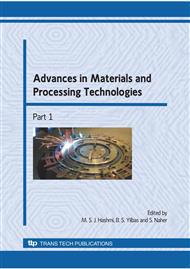p.375
p.384
p.392
p.400
p.407
p.415
p.421
p.429
p.439
Effect of Heat Treatment Conditions on the High Temperature Deformation of 6082-Al Alloy
Abstract:
High-temperature deformation of an artificially aged 6082-Al alloy was conducted in the present investigation. Tensile tests were carried out at temperatures of 623, 673 and 723 K at various strain rates ranging from 5x10-5 to 2x10-2 s-1. The behavior of the alloy is characterized by high stress exponent, n and high apparent activation energy, Qa that are higher than what is usually observed in Al and Al solid-solution alloys under similar experimental conditions, which implies the presence of threshold stress; this behavior results from dislocation interaction with second phase particles. The threshold stress, σo values were seen to decrease exponentially with temperature. By incorporating the threshold stress in the analysis, the true activation energy, Qt was calculated to be close to that of dislocation pipe diffusion in Al. Analysis of the experimental data of the alloy in terms of the Zener- Hollomon parameter vs. normalized effective stress, revealed a single type of deformation behavior with an n value of ~7. Measurements showed that the values of elongation percent at failure increase with strain rate and temperature.
Info:
Periodical:
Pages:
407-414
Citation:
Online since:
December 2009
Authors:
Price:
Сopyright:
© 2010 Trans Tech Publications Ltd. All Rights Reserved
Share:
Citation:


